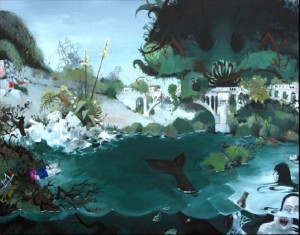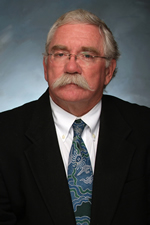The week that was, 5/2-8/2010
Posted on | May 9, 2010 | 1 Comment

Click on the image for NOAA updates and links to the British Petroleum / Deepwater Horizon oil spill.
Due to heightened interest in the Deepwater Horizon oil spill, media aircraft have been conducting low flights and landings on Breton National Wildlife Refuge’s Chandeleur Islands. These flights and landings threaten the very birds that the media are covering and that the public is concerned about. — Deepwater Horizon Response on Facebook, May 8, 2010
“It’s the ocean, baby.” — Jim O’Brien, Florida State University oceanographer and meteorologist, “Grand Ole Opry flood and other crazy weather: El Niño’s fault?” Christian Science Monitor, May 4, 2010
Why do people wait and watch the water rise? Why do they keep their luggage in the boat and themselves in water the color of milky coffee that is no doubt full of snakes? — “Our deluge, drop by drop,” an op-ed on the Tennessee floods, The New York Times, May 4, 2010
Warming the planet will cause many other climatic patterns to change at speeds unprecedented in modern times … — Letter signed by 255 scientists asserting the existence of climate change, “Climate change and the integrity of science,” Science, May 7, 2010

Science magazine Photoshopped climate bear. Click on the image for Peter Gleick's response in the Huffington Post.
Along with the letter the magazine published a picture of a lonely polar bear floating on a small ice floe … Turns out the picture was Photoshopped, and even worse, this fact was not apparent to readers of the letter. The climate-change deniers jumped all over this. — “Earth to Science magazine: Are you stupid, clueless or conspiratorial or what?” WaterWired, May 9, 2010
NOAA’s State of the Climate report shows the April 2010 average temperature for the contiguous United States was 54.3 degrees F, which is 2.3 degrees F above the long-term (1901-2000) average (14th warmest April on record). — “Above normal temperatures and below normal precipitation in April,” National Oceanic and Atmospheric Administration, May 7, 2010
“This is everyone’s worst nightmare in the water industry.” — Frederick A. Laskey, executive director of the Massachusetts Water Resources Authority, “A ‘catastrophic’ rupture hits region’s water system,” The Boston Globe, May 2, 2010
“You don’t budget for catastrophic failures on pipes less than a decade old.” — Joe Favaloro, Massachusetts Water Resources Authority advisory board executive director, “Tunnel failure came before back-up could be finished,” The Boston Globe, May 2, 2010
The water authority has five bosses who earn as much or more than the governor. They also have 170 employees who top $100,000 annually. Top Salary: $163,937, Executive Director Frederick Laskey. — “Dozens of salaries beat Governor Patrick’s,” The Boston Herald, May 6, 2010
Water pay here is demonstrably top heavy. Of the 1,600 employees, 496 of them or nearly 30%, earn $90,000 or more. At the very top, the amounts are considerable. SNWA General Manager Pat Mulroy has the highest base salary of any employee in any public agency, earning a hefty $290,000. — “Public Trust: Water Authority salaries,” I-Team, KLAS TV, Channel 8, Las Vegas, May 5, 2010
How’s this for irony: If Missouri American Water gets the big rate increase it wants for customers in St. Joseph, seemingly the worst thing we could do in response would be to cut our water consumption. — “Irony at the water faucet,” St Joseph News-Press, May 6, 2010
“If you want a monument to Chips Barry, just turn on your water faucet.” — Former Colorado Governor Dick Lamm, “Water chief Barry dies in farm accident,” Denver Post, May 4, 2010
During his tenure at Denver Water, the utility implemented a conservation program that is nationally and internationally recognized as a model of success, built a recycled water distribution system, invested millions of dollars in improvements at its treatment facilities, monitored recovery from several devastating wildfires in Denver Water’s watershed and led the work to recover from one of the worst droughts in the city’s history. — “Chips Barry toast and celebration,” Denver Water announcement of a commemoration planned for May 21
“I really think the elite were using this as a kind of showing off, a display of wealth and power to say, ‘We can do this, we can make water rise right out of the ground.’ ” — Kirk D. French, discoverer of a Mayan aqueduct-tunnel system in Palenque, Mexico, “First pressurized water system in the Americas found,” Los Angeles Times, May 7, 2010
“I have no problem with garden gnomes or lawn-jockeys, if that’s your thing. But lawns are thirsty, and in Southern California we get nearly all of our water by dipping our straw in someone else’s drink.” — Ed Begley, Jr from “Twelve things the world should toss out,” The Washington Post, May 9, 2010*
“It’s not a pleasant subject but unblocking clogged drains is even more unpleasant for our staff across Scotland.” — Scottish Water employee Jane McKenzie, “False teeth, mobile phones and even a live snake all go down the drain,” Paisley Daily Express, May 4, 2010
… the 1942 compact … allotted 300,000 acre-feet a year for Nebraska, 240,000 acre-feet a year for Kansas and 40,000 acre-feet a year for Colorado. Kansas officials argue that Kansas is losing 16 percent of its water under the compact. — “Kansas asks high court to rule on Republican River draws,” Denver Post, May 5, 2010
“Nebraska isn’t listening.” — Kansas Attorney General Steve Six, “Kansas seeks sanctions against Nebraska,” North Platte Telegraph, May 5, 2010
“We have an absolute emphasis on conservation, reuse and local-scale projects.” — Paul Steinbrecher, environmental services director, Jacksonville Electric Authority, “River water, re-using water will both cost more,” The Florida Times-Union, May 6, 2010
Storm water ponds with the best water quality tend to be a bit bigger than others, with a population of native plants that grow underwater. Many also are partially surrounded by buffers of natural vegetation that help absorb or catch pollutants before they reach the water. — “Bloomington battles green ponds,” Minneapolis-St Paul Star Tribune, May 4, 2010

"Water & Power" by Ako Castuera on display at the Pasadena Museum of California Art through May 30, 2010. Click on the image to be taken to the museum's website.
“I found my cultural identity in the river. The broken bottles sparkling in the light of the moon and the sound of the water and speeding cars was very romantic.” — Los Angeles artist Chaz Bojorquez, “Art and the LA River,” Los Angeles Times, May 9, 2010*
“No one can say this is holy water. The Jordan River has become holy shit …” — Gidon Bromberg of the Israeli-Palestinian-Jordanian environmental NGO Friends of Earth Middle East, “Jordan River ‘to run dry next year,'” Al Jazeera, May 8, 2010
“We’re not expecting that it will show any benefit for the fish. And that’s fine. We would like to get through this [test] and get this off the table.” — “Libby Dam spill test for sturgeon planned in June,” Bruce Measure, Montana delegate to an hydropower oversight panel for the Columbia River, Daily Interlake, May 7, 2010
Hundreds of students cried off a planned water fight in Bath – because it was raining. — “Water fight is a damp squib,” The Bath Chronicle, May 9, 2010*
The plants’ once-through cooling systems kill 2.6 million fish, 19 billion fish larvae and 57 seals, sea lions and sea turtles each year. — Dominic Gregorio, California Water Resources Control Board ocean unit chief, “California rules restrict power plants’ marine water use,” Wall Street Journal, May 5, 2010
That water is from Arizona’s Lake Mead and from Mexico. — Explanation of how water has been secured for the Cienega Santa Clara after the Yuma Desalting Plant resumed operation, “US-Mexico deal aims to protect wetland,” Arizona Daily Star, May 9, 2010 (Pass the map – Ed).*
“There is a problem here.” — New Jersey Department of Environmental Protection Commissioner Bob Martin, “Tainted nuke plant water reaches major NJ aquifer,” Associated Press, May 8, 2010
“If they take away the black waters we will die of hunger” — Hidalgo farmer Gregorio Cruz Alamilla, “Fears that a lush land may lose a foul fertilizer,” The New York Times, May 4, 2010

But can you take it on a plane? Click on clock to be taken to the website of the manufacturer of the Bedol water-powered alarm clock.
The clock has a small water tank and turns the ions in the water into the electrical current used to operate it. The tank needs to be refilled every 10 weeks. — “Water keeps this clock running,” Pittsburgh Tribune-Review, May 7, 2010
The only time anyone ever does a Water Effects Ratio study is to get out of complying with water quality standards to protect human health and aquatic life. — Mark Gold, president of Heal the Bay, Spouting Off, May 7, 2010
“Yes, there is a drought. Inflows are down. The main reason for this is the fact that we had a judge that said ship all the water down the river and we are the fall guys.” — Oregon fertilizer dealer Bob Gasser, “Klamath farmers will see a fraction of water needs,” AP / Oregonian, May 6, 2010
For a complete run-down of articles on California’s water, go to Aguafornia and UC Berkeley’s On Water.
*Some stories from May 9 are included in this post. Emily Green is on assignment. ‘The week that was’ will return as time allows.
This post was updated at 5.26pm PST. The WaterWired item was added.
Comments
One Response to “The week that was, 5/2-8/2010”
Leave a Reply





May 10th, 2010 @ 12:52 pm
In the frozen water department, April snow cover for North America was the most extreme (low) anomaly, and not by a little, over the period of record. Winter saw some quite high anomalies, which means that the melt-back was even more extreme.